steering CADILLAC SEVILLE 1993 4.G Owners Manual
[x] Cancel search | Manufacturer: CADILLAC, Model Year: 1993, Model line: SEVILLE, Model: CADILLAC SEVILLE 1993 4.GPages: 407, PDF Size: 22.28 MB
Page 9 of 407
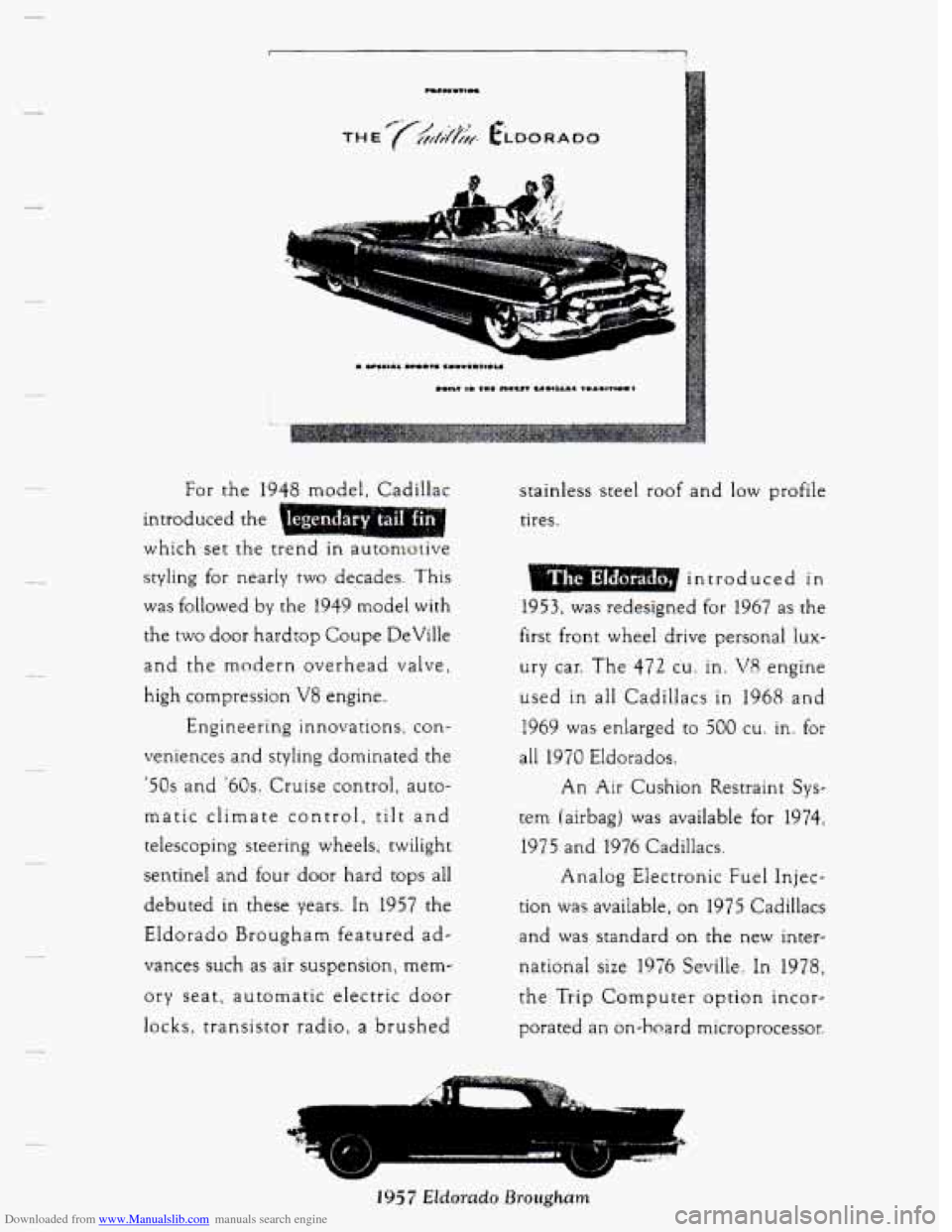
Downloaded from www.Manualslib.com manuals search engine For the 1948 model, Cadillac
introduced
the
which set the trend in autonlotive
styling for nearly
two decades. This
was followed by the 1949 model with
the two door hardtop Coupe DeVille
and
the modern overhead valve,
high compression
V8 engine.
Engineering innovations, con-
veniences and styling dominated the
'50s and '60s. Cruise control, auto-
matic climate control,
tilt and
telescoping steering wheels, twilight
sentinel and four door hard tops all
debuted in these years. In
1957 the
Eldorado Brougham featured ad-
vances such as air suspension, mem-
ory seat, automatic electric door
locks, transistor radio,
a brushed stainless steel
roof and
low profile
tires.
r' , The .. . . : ... . ...,:
t prado,l introduced in
1953, was redesigned for 1967 as the
first front wheel drive personal lux-
ury car.
The 472 cu. in. V8 engine
used in all Cadillacs in
1968 and
1969 was enlarged to 500 cu. in. for
all 1970 Eldorados.
An Air Cushion Restraint Sys-
tem (airbag) was available for 1974,
1975 and
1976 Cadillacs.
Analog Electronic Fuel Injec-
tion was available, on
1975 Cadillacs
and was standard on the new inter-
national size
7976 Seville. In 1978,
the Trip Computer option incor-
porated an on-board microprocessor.
1957 Eldorado Brougham
Page 10 of 407
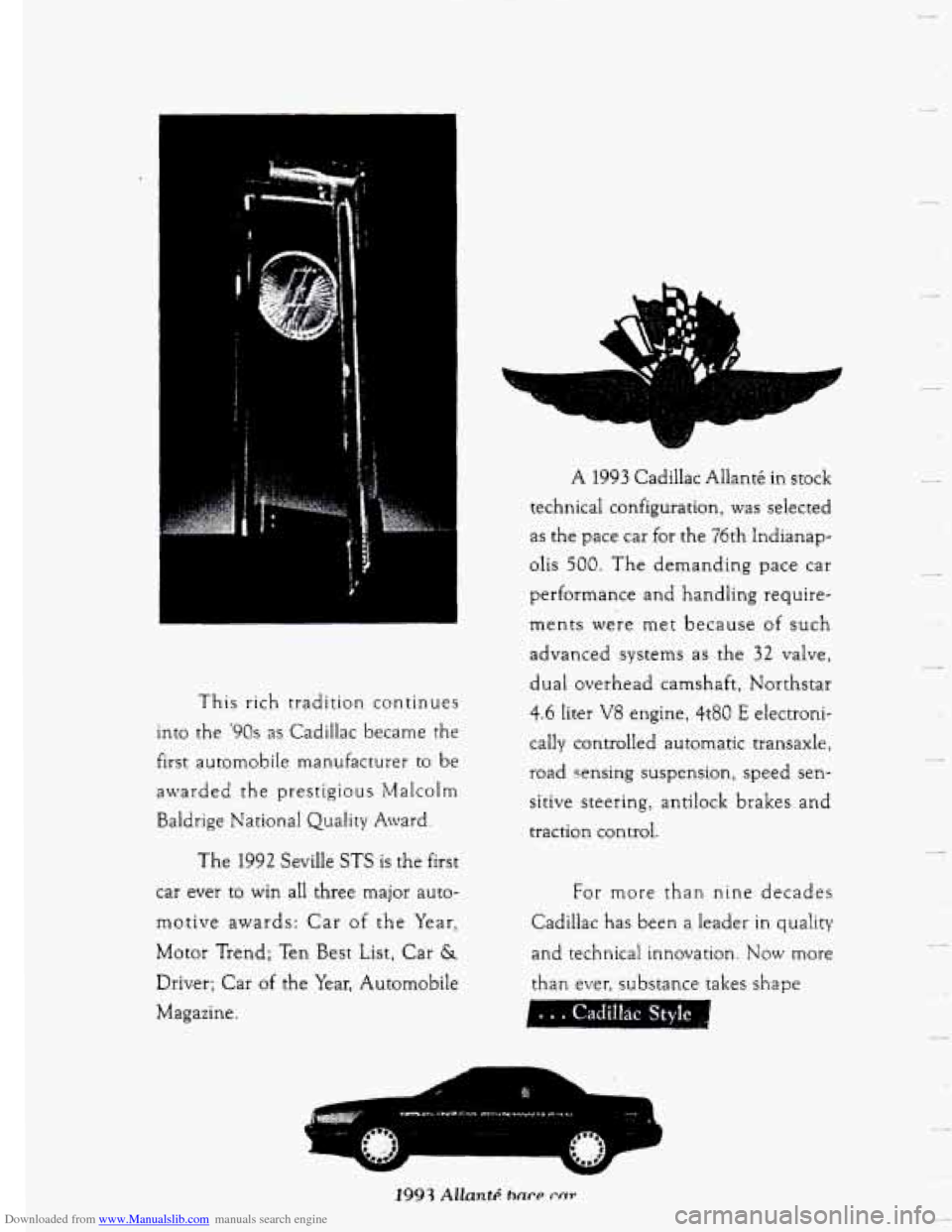
Downloaded from www.Manualslib.com manuals search engine This rich tradition continues
into the '90s as Cadillac became the
first automobile manufacturer
to be
awarded the prestigious Malcolm
Baldrige National
Quality Award.
The 1992 Seville STS is the first
car ever to win all three major auto-
motive awards: Car
of the Year,
Motor Trend; Ten Best List, Car
&
Driver; Car of the Year, Automobile
Magazine.
A 1993 Cadillac Allant6 in stock
technical configuration, was selected
as the pace car for the 76th Indianap-
olis
500. The demanding pace car
performance and handling require-
ments were met because
of such
advanced systems as the
32 valve,
dual overhead camshaft, Northstar
4.6 liter V8 engine, 4t80 E electroni-
cally controlled automatic transaxle,
road sensing suspension, speed sen-
sitive steering, antilock brakes and
traction control.
For more
than nine decades
Cadillac has been a leader in quality
and technical innovation.
Now more
than ever, substance takes shape
Page 46 of 407
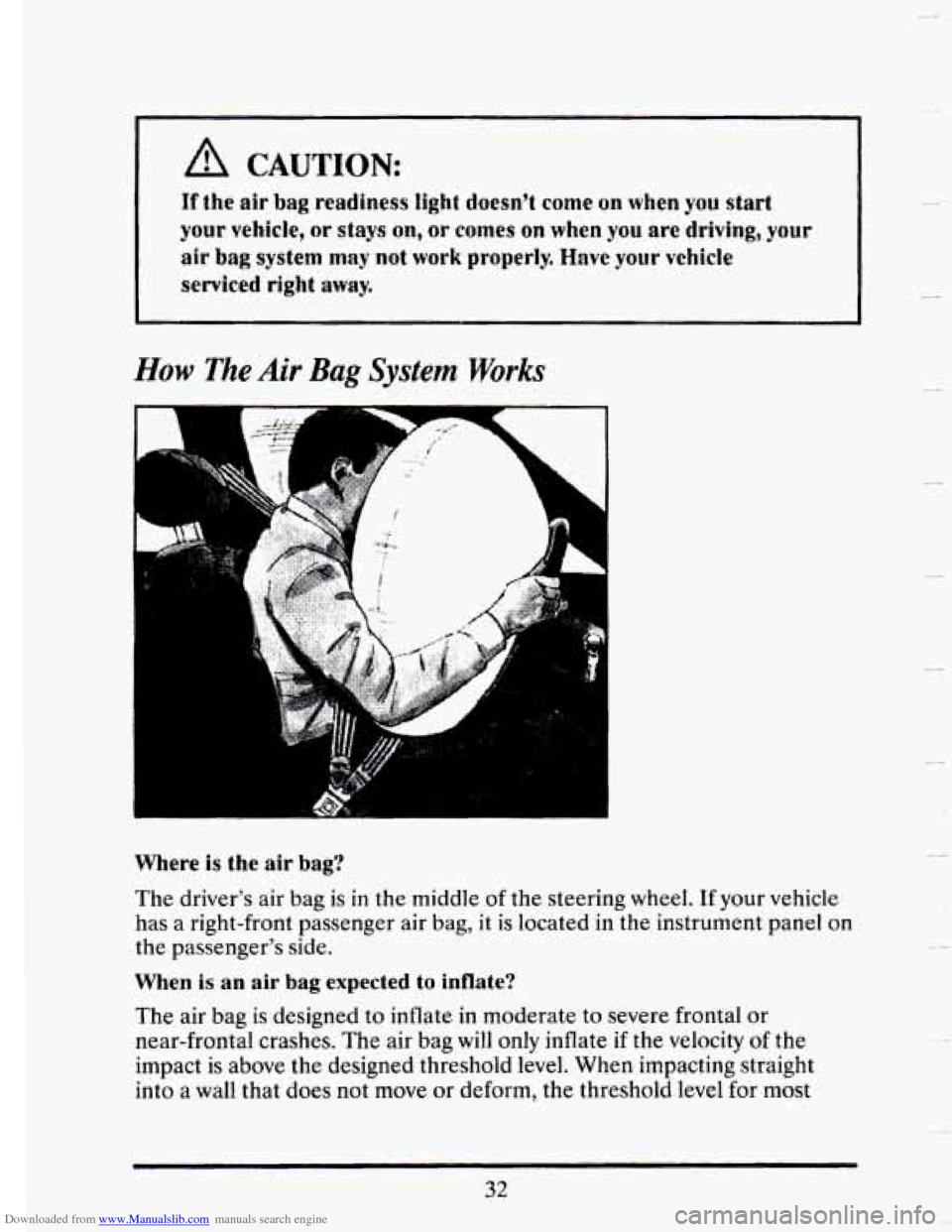
Downloaded from www.Manualslib.com manuals search engine I 1
If the air bag readiness light doesn't come on when you start
your vehicle, or stays on, or comes on when you are driving, your
air bag system may not work properly Have your vehicle
serviced right away
How The Air Bag System Works
..
. ..
Where is the air bag?
The driver's air bag is in the middle of the steering wheel. If your vehicle
has
a right-front passenger air bag, it is located in the instrument panel on
the passenger's side.
When is an air bag expected to inflate?
The air bag is designed to inflate in moderate to severe frontal or
near-frontal crashes.
The air bag will only inflate if the velocity of the
impact
is above the designed threshold level. When impacting straight
into
a wall that does not move or deform, the threshold level for most
32
i
Page 47 of 407
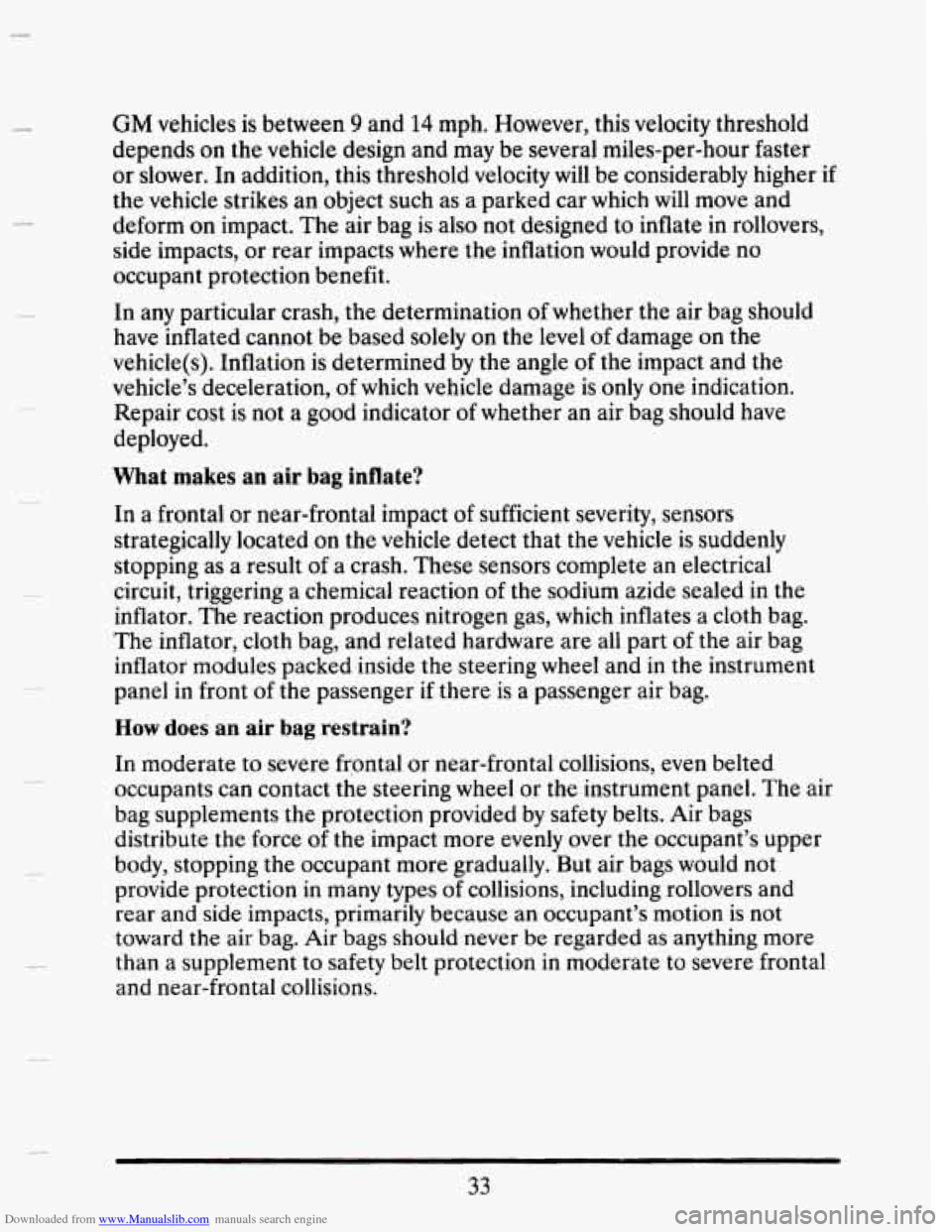
Downloaded from www.Manualslib.com manuals search engine GM vehicles is between 9 and 14 mph. However, this velocity threshold
depends
on the vehicle design and may be several miles-per-hour faster
or slower. In addition, this threshold velocity will be considerably higher
if
the vehicle strikes an object such as a parked car which will move and
deform on impact. The air bag is also not designed to inflate in rollovers,
side impacts,
or rear impacts where the inflation would provide no
occupant protection benefit.
In any particular crash, the determination
of whether the air bag should
have inflated cannot be based solely on the level
of damage on the
vehicle(s). Inflation is determined by the angle
of the impact and the
vehicle’s deceleration,
of which vehicle damage is only one indication.
Repair cost is not a good indicator of whether an air bag should have
deployed.
What makes an air bag inflate?
In a frontal or near-frontal impact of sufficient severity, sensors
strategically located on the vehicle detect that the vehicle
is suddenly
stopping as a result
of a crash. These sensors complete an electrical
circuit, triggering a chemical reaction
of the sodium azide sealed in the
inflator.
The reaction produces nitrogen gas, which inflates a cloth bag.
The inflator, cloth bag, and related hardware are all part of the air bag
inflator modules packed inside the steering wheel and in the instrument
panel
in front of the passenger if there is a passenger air bag.
How does an air bag restrain?
In moderate to severe fr,ontal or near-frontal collisions, even belted
occupants can contact the steering wheel or the instrument panel. The air
bag supplements the protection provided by safety belts. Air bags
distribute the force
of the impact more evenly over the occupant’s upper
body, stopping the occupant more gradually. But air bags would not
provide protection in many types
of collisions, including rollovers and
rear and side impacts, primarily because an occupant’s motion is not
toward
the air bag. Air bags should never be regarded as anything more
than a supplement to safety belt protection
in moderate to severe frontal
and near-frontal collisions.
33
Page 48 of 407
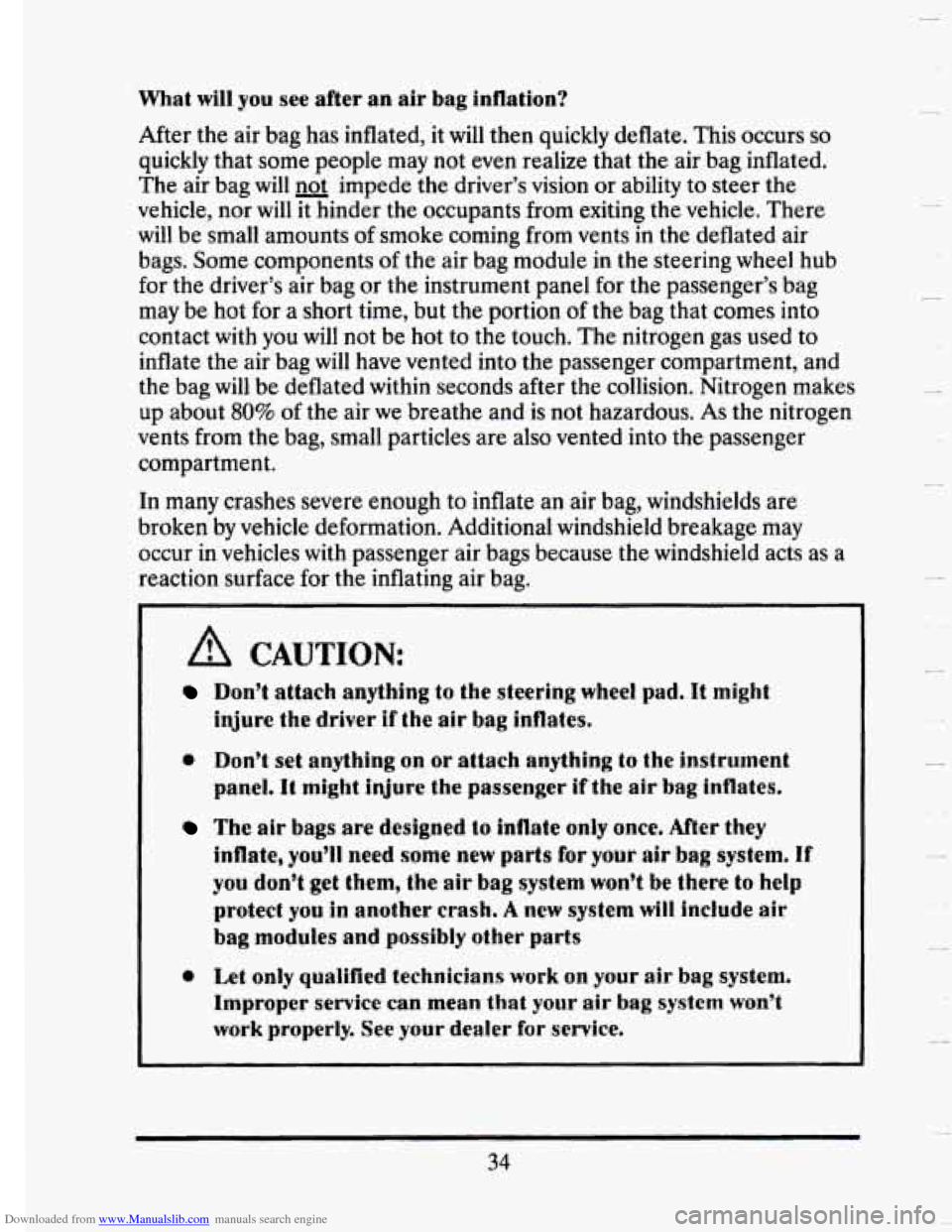
Downloaded from www.Manualslib.com manuals search engine What will you see after an air bag inflation?
After the air bag has inflated, it will then quickly deflate. This occurs so
quickly that some people may not even realize that the air bag inflated.
The air bag will
not impede the driver’s vision or ability to steer the
vehicle, nor will it hinder the occupants from exiting the vehicle. There
will be small amounts
of smoke coming from vents in the deflated air
bags. Some components
of the air bag module in the steering wheel hub
for the driver’s air bag
or the instrument panel for the passenger’s bag
may be
hot for a short time, but the portion of the bag that comes into
contact with
you will not be hot to the touch. The nitrogen gas used to
inflate the air bag
will have vented into the passenger compartment, and
the bag will be deflated within seconds after the collision. Nitrogen makes
up about
80% of the air we breathe and is not hazardous. As the nitrogen
vents from the bag, small particles are also vented into the passenger
compartment.
In many crashes severe enough to inflate an air bag, windshields are
broken
by vehicle deformation. Additional windshield breakage may
occur in vehicles with passenger air bags because
the windshield acts as a
reaction surface for the inflating air bag.
A CAUTION:
Don’t attach anything to the steering wheel pad. It might
injure the driver if the air bag inflates.
@ Don’t set anything on or attach anything to the instrument
panel. It might injure the passenger if the air bag inflates.
The air bags are designed to inflate only once. After they
inflate, you’ll need some new parts for your air bag system. If
yau don’t get them, the air bag system won’t be there to help
protect you in another crash. A new system will include air
bag moduCes and possibly other parts
0 Let only qualified technicians work on your air bag system.
Improper service can mean that your air bag system won’t
work properly. See your dealer for service.
34
c
Page 49 of 407
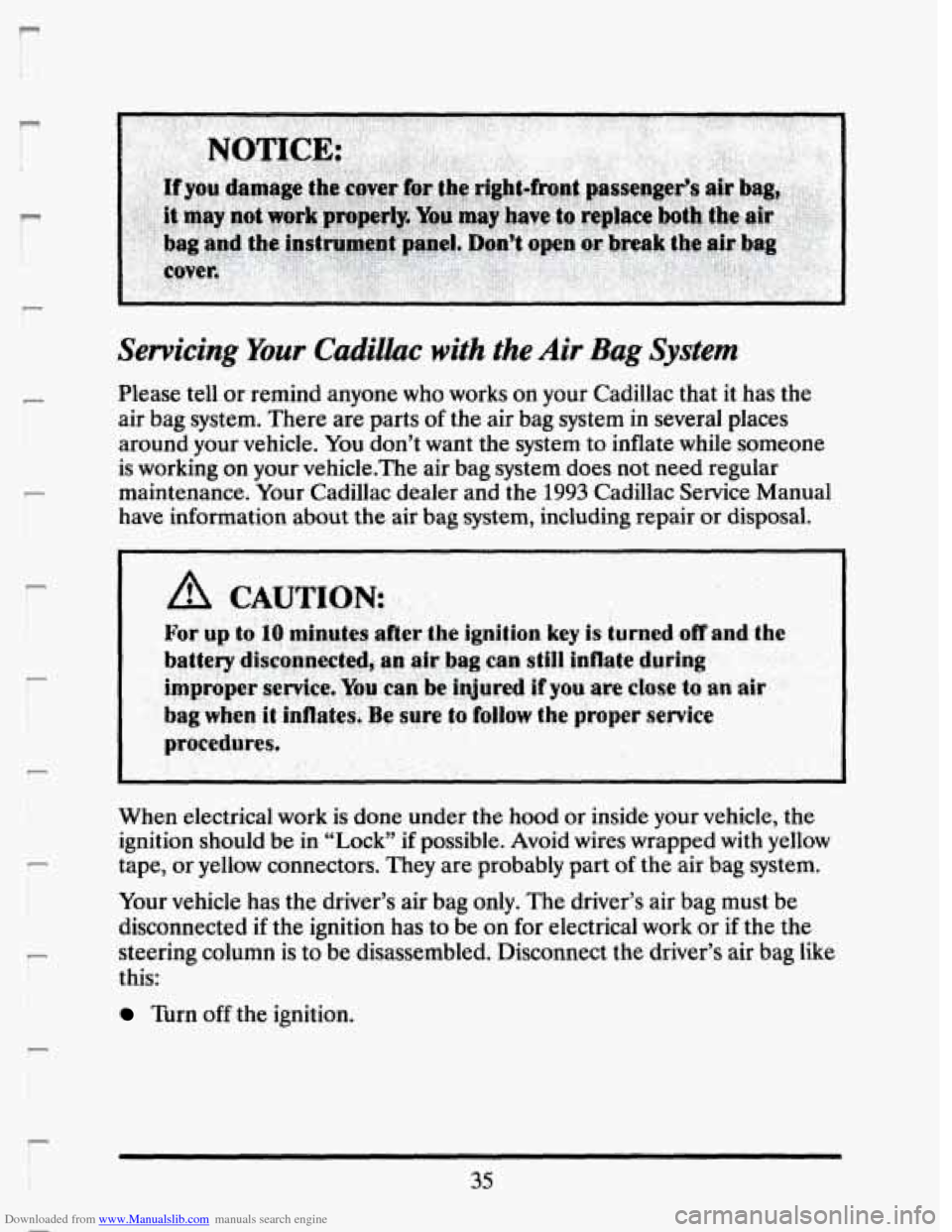
Downloaded from www.Manualslib.com manuals search engine r
F
r
r
Servicing Your Cadillac with the Air Bag System
Please tell or remind anyone who works on your Cadillac that it has the
air bag system. There are parts
of the air bag system in several places
around your vehicle. You don’t want the system to inflate while someone
is working
on your vehicle.The air bag system does not need regular
maintenance. Your Cadillac dealer and the
1993 Cadillac Service Manual
have information about the air
bag system, including repair or disposal.
When electrical work
is done under the hood or inside your vehicle, the
ignition should be
in “Lock” if possible. Avoid wires wrapped with yellow
tape, or yellow connectors. They are probably part
of the air bag system.
Your vehicle has the driver’s air bag only. The driver’s air bag must be
disconnected
if the ignition has to be on for electrical work or if the the
steering column is
to be disassembled. Disconnect the driver’s air bag like
this:
Turn off the ignition.
35
Page 50 of 407
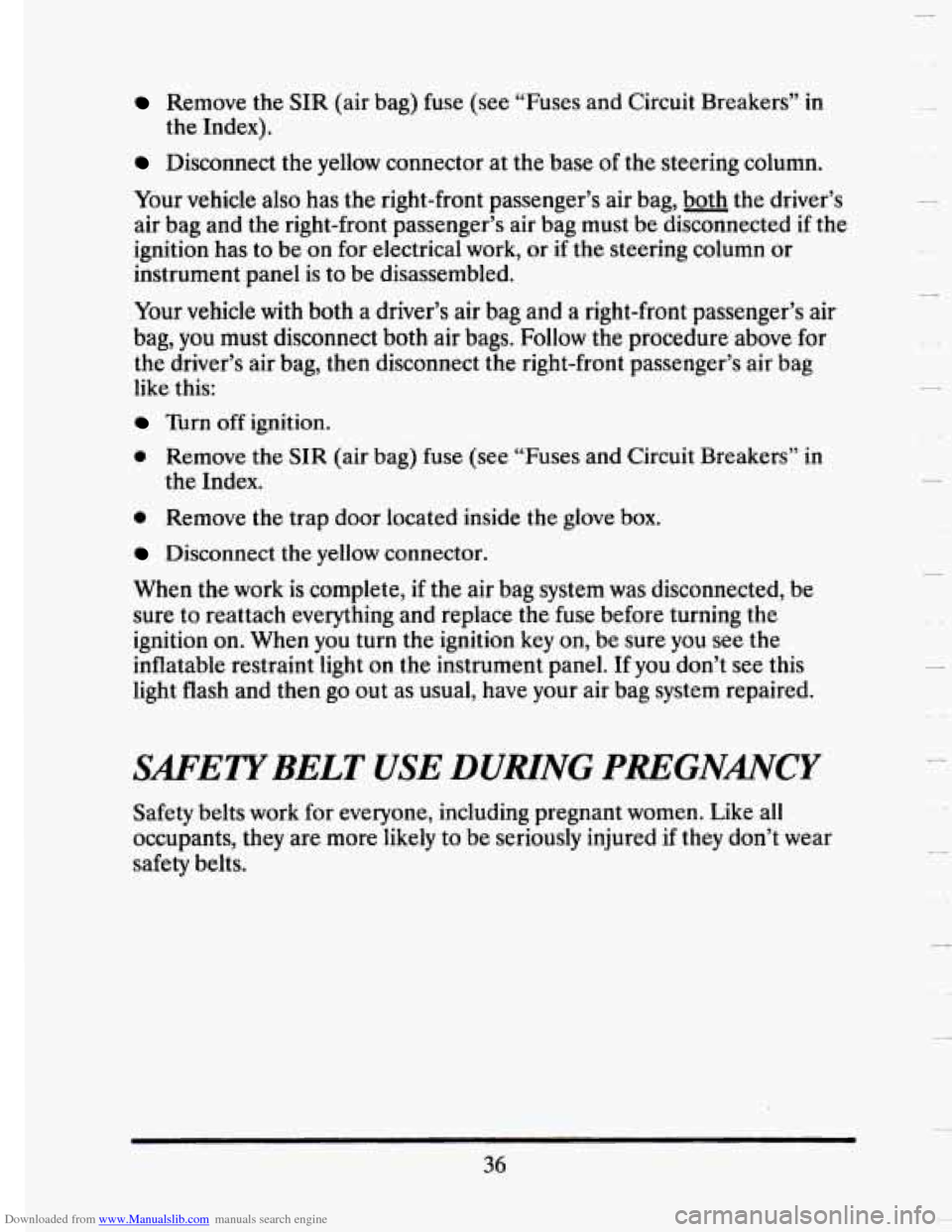
Downloaded from www.Manualslib.com manuals search engine Remove the SIR (air bag) fuse (see “Fuses and Circuit Breakers’’ in
the Index).
Disconnect the yellow connector at the base of the steering column.
Your vehicle
also has the right-front passenger’s air bag, both the driver’s
air bag and the right-front passenger’s air bag must be disconnected
if the
ignition has
to be on for electrical work, or if the steering column or
instrument panel is to be disassembled.
Your vehicle with both
a driver’s air bag and a right-front passenger’s air
bag,
you must disconnect both air bags. Follow the procedure above for
the driver’s
air bag, then disconnect the right-front passenger’s air bag
like this:
Turn off ignition.
0 Remove the SIR (air bag) fuse (see “Fuses and Circuit Breakers” in
the Index.
0 Remove the trap door located inside the glove box.
Disconnect the yellow connector.
When the work
is complete, if the air bag system was disconnected, be
sure to reattach everything and replace the fuse before turning the
ignition on. When you turn the ignition
key on, be sure you see the
inflatable restraint light
on the instrument panel. If you don’t see this
light flash and then go out as usual, have your air bag system repaired.
S’.ETYBELT USE DURING PREGNMCY
Safety belts work for everyone, including pregnant women. Like all
occupants, they
are more likely to be seriously injured if they don’t wear
safety belts.
36
c
Page 89 of 407
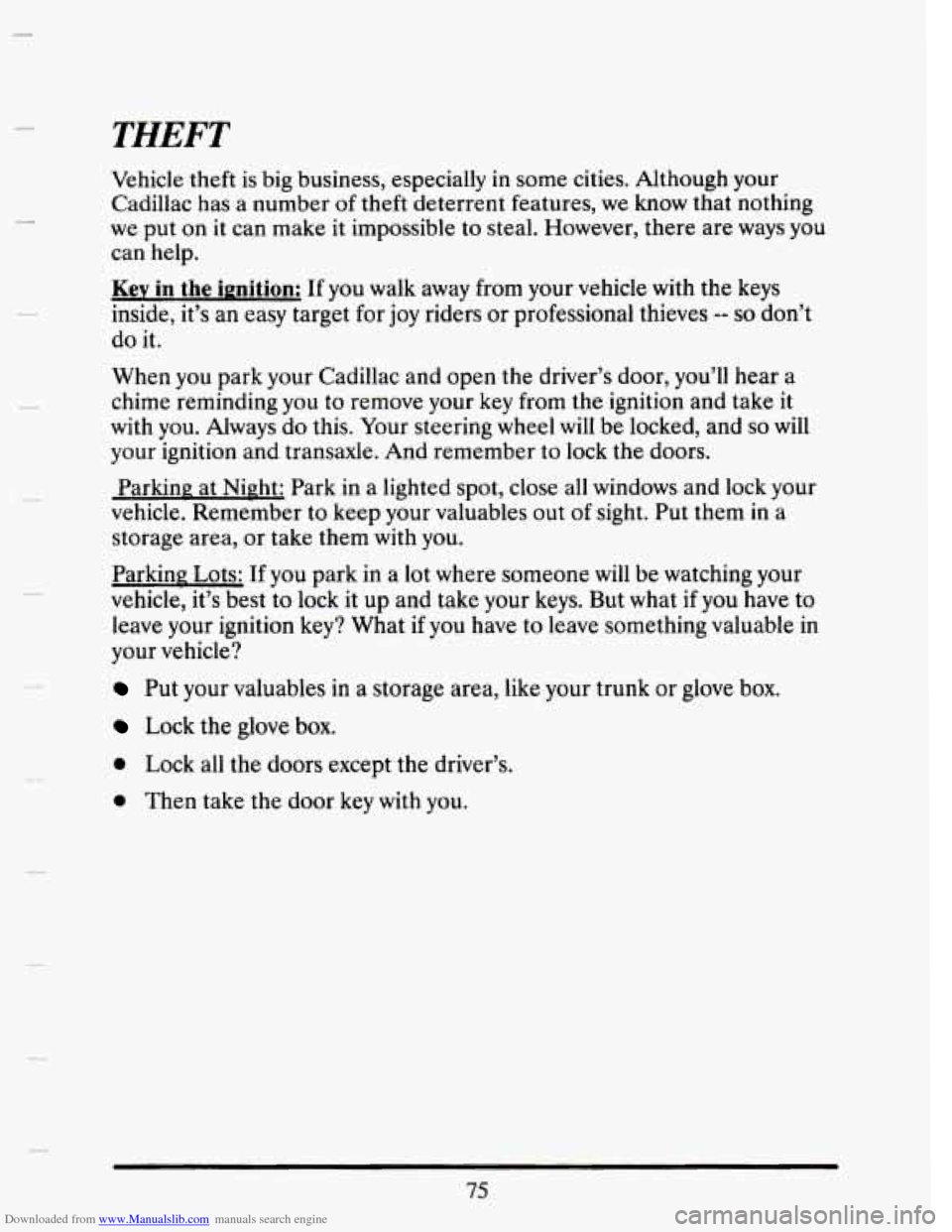
Downloaded from www.Manualslib.com manuals search engine THEFT
Vehicle theft is big business, especially in some cities. Although your
Cadillac has
a number of theft deterrent features, we know that nothing
we put on it can make it impossible
to steal. However, there are ways you
can help.
Key in the imition: If you walk away from your vehicle with the keys
inside, it’s an easy target for joy riders or professional thieves
-- so don’t
do
it.
When you park your Cadillac and open the driver’s door, you’ll hear a
chime reminding you to remove your key from the ignition and take
it
with you. Always do this. Your steering wheel will be locked, and so will
your ignition and transaxle. And remember to lock
the doors.
Parkina
at Night: Park in a lighted spot, close all windows and lock your
vehicle. Remember
to keep your valuables out of sight. Put them in a
storage area, or take them
with you.
Parkina Lots: If you park in a lot where someone will be watching your
vehicle, it’s best to lock it up and take your keys. But what if you have to
leave your ignition key? What
if you have to leave something valuable in
your vehicle?
Put your valuables in a storage area, like your trunk or glove box.
Lock the glove box.
0 Lock all the doors except the driver’s.
a Then take the door key with you.
75
Page 93 of 407
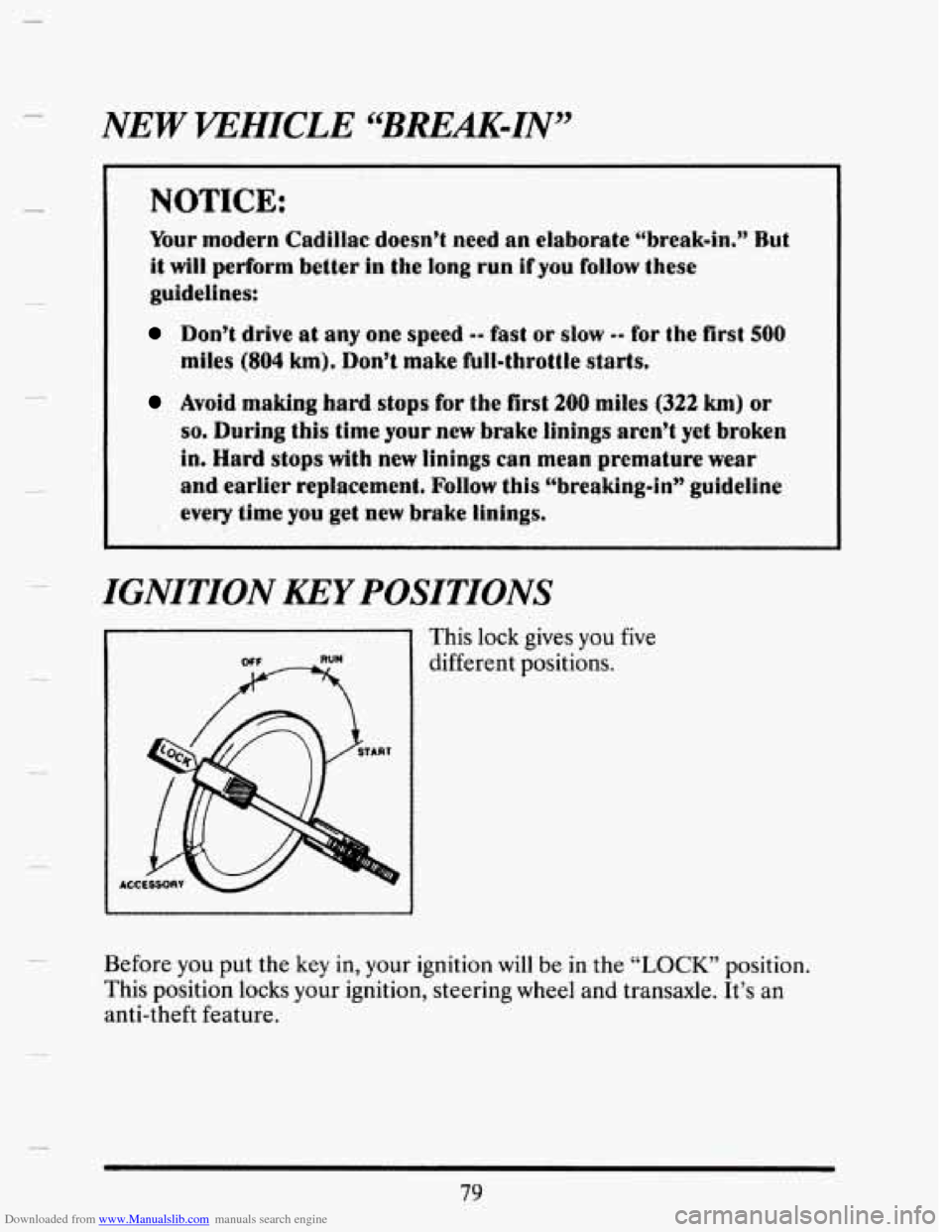
Downloaded from www.Manualslib.com manuals search engine NEW VEHICLE “BREAK-IN”
NOTICE:
Your modern Cadillac doesn’t need an elaborate “break-in,” Rut
it will perQarm better in the long run if you fotlow these
guidelines:
Don3 drive st any one speed 9- fast or slow -0 €or the First SUO
miles (804 h), Don’t make fulf~throttle starts,
Avoid making hard stops for the first 200 miles (322 km) or
so. During this time your new brake linings aren’t yet broken
in. Hard stops with new linings can mean premature wear
and earlier replacement. Follow this C4breaking-in’p guideline
ewry time you get new brake linings.
IGNITION KEY POSITIONS
This lock gives you five
different positions.
Before you put the key in, your ignition will
be in the “LOCK” position.
This position
locks your ignition, steering wheel and transaxle. It’s an
anti-theft feature.
79
Page 94 of 407
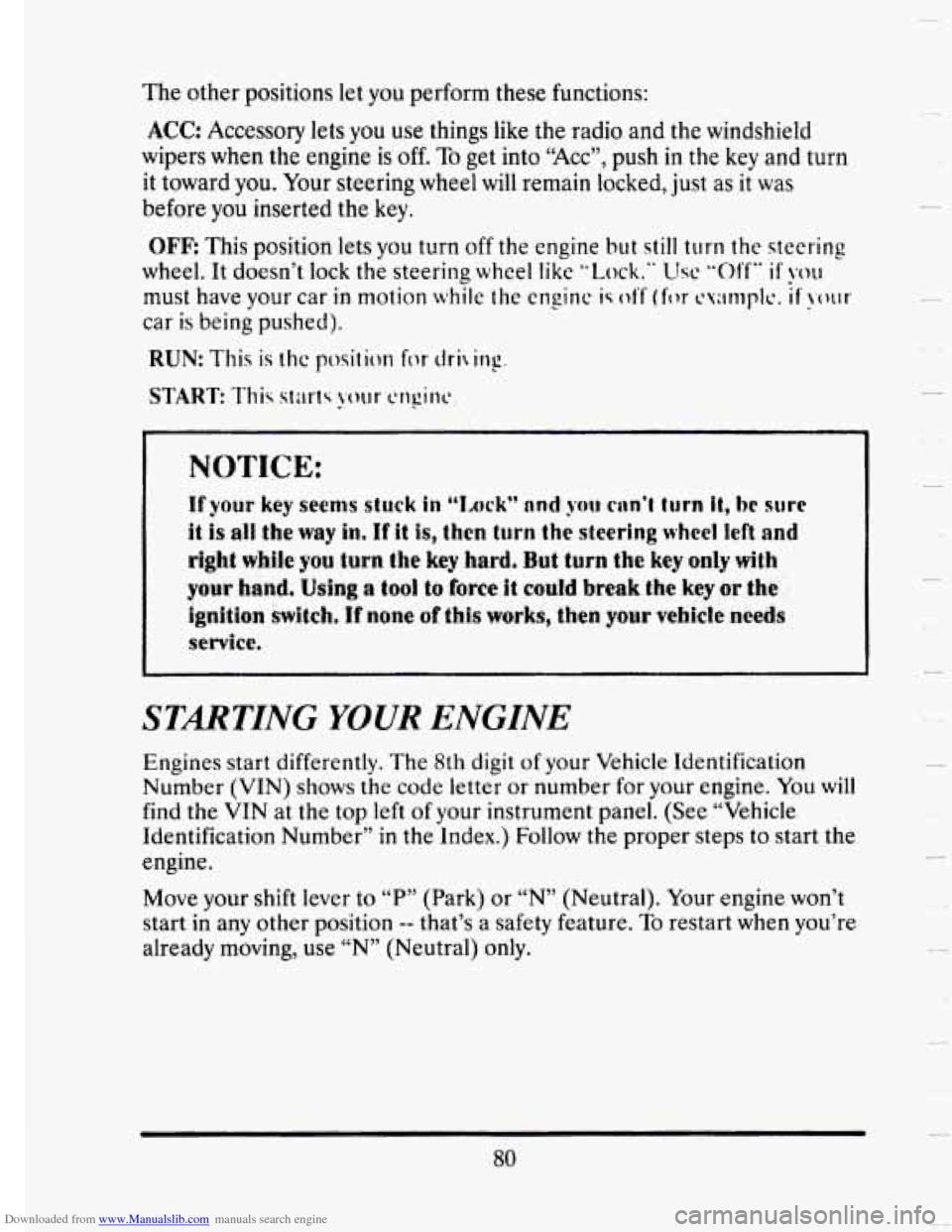
Downloaded from www.Manualslib.com manuals search engine The other positions let you perform these functions:
ACC: Accessory lets you use things like the radio and the windshield
wipers when the engine
is off. To get into “ACC”, push in the key and turn
it toward
you. Your steering wheel will remain locked, just as it was
before you inserted the key.
OFF: This position lets you turn off the engine but still turn the steering
wheel. It doesn’t lock the steering wheel like “Lock.“ Use ”Off” if WLI
must have your car in motion while the engine is off (for cu:rnlplc*. if >.our
car is being pushed).
NOTICE:
If your key seems stuck in “Imk” rrnd you cdl turn it, be sure
it is all the way in. If it is, then turn the steering wheel left and
fight while you turn the key hard, But turn the key only with
your hand. Using a toooil to force it could break the key or the
ignition switch, If none .of this works, then your vehicle needs
service.
STARTING YOUR ENGINE
Engines start differently. The 8th digit of your Vehicle Identification
Number (VIN) shows
the code letter or number for your engine. You will
find the VIN at the top left
of your instrument panel. (See “Vehicle
Identification Number” in the Index.) Follow the proper steps
to start the
engine.
Move your shift lever to
“P” (Park) or “N” (Neutral). Your engine won’t
start in any other position
-- that’s a safety feature. To restart when you’re
already moving, use
“N” (Neutral) only.
80
H
c
J-r